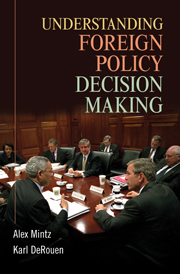Book contents
- Frontmatter
- Contents
- Acknowledgments
- PART ONE INTRODUCTION
- 1 Why Study Foreign Policy from a Decision-Making Perspective?
- PART TWO THE DECISION ENVIRONMENT
- PART THREE MODELS OF DECISION MAKING
- PART FOUR DETERMINANTS OF FOREIGN POLICY DECISION MAKING
- PART FIVE MARKETING FOREIGN POLICY
- PART SIX CONCLUSION
- Appendix: Foreign Policy Simulation and Exercise
- References
- Index
1 - Why Study Foreign Policy from a Decision-Making Perspective?
Published online by Cambridge University Press: 05 June 2012
- Frontmatter
- Contents
- Acknowledgments
- PART ONE INTRODUCTION
- 1 Why Study Foreign Policy from a Decision-Making Perspective?
- PART TWO THE DECISION ENVIRONMENT
- PART THREE MODELS OF DECISION MAKING
- PART FOUR DETERMINANTS OF FOREIGN POLICY DECISION MAKING
- PART FIVE MARKETING FOREIGN POLICY
- PART SIX CONCLUSION
- Appendix: Foreign Policy Simulation and Exercise
- References
- Index
Summary
Foreign policy choices range from the dramatic to the mundane. Leaders make decisions to go to war, make peace, form an alliance, establish diplomatic relations, implement a position on nuclear nonproliferation, impose economic sanctions, or ratify global environmental agreements. The focus of this book is this broad range of decisions.
We approach this topic from a number of directions. We consider, among others, the type of the decision (one-shot, sequential, interactive, group), the level of analysis in foreign policy decision making (the individual, group, coalition), the processes and dynamics that lead to the decision, biases and errors, and, of course, models of decision making (rational actor, cybernetic, bureaucratic politics, organizational politics, poliheuristic theory, and prospect theory). We examine the determinants of foreign policy decisions (the decision environment, psychological factors, international factors, and domestic influences). We look at a host of psychological factors that shape decisions, such as images and belief systems, emotions, analogies, the personality of leaders, leadership style, miscalculations and misperceptions, and environmental factors such as time constraints, ambiguity, stress, and risk. We then look at the effect of international and domestic factors such as deterrence, the arms race, the regime type of the adversary, strategic surprise, economic conditions, public opinion, and electoral cycles on foreign policy decision making. We conclude with a case study of the U.S. decision to invade Iraq in 2003, analyzed through five decision models.
- Type
- Chapter
- Information
- Understanding Foreign Policy Decision Making , pp. 3 - 12Publisher: Cambridge University PressPrint publication year: 2010



